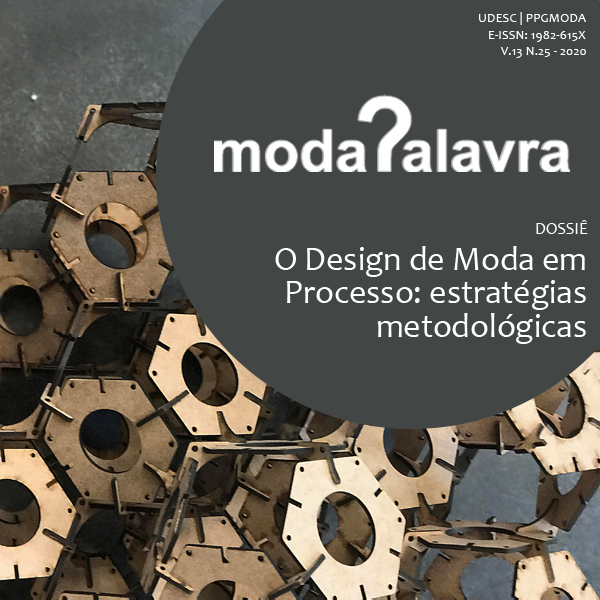Is it Possible to Quantify the Functions of the Dress? a question for functional analysis methods indesign
DOI:
https://doi.org/10.5965/1982615x13272020138Keywords:
clothing design, unctional analysis methods, clothed-bodyAbstract
When we face the study of dress from its artifactual identity, we observe that its so - called functional dimension cannot be understood in the same terms proposed by the ergonomics of the product, that is, from the ergonomic concepts of usability, efficiency, effectiveness and psychological comfort in relation to a specific activity or work. This article, presents the results of a review of the functional analysis methods commonly used by design for the study of clothing, and explains why they are insufficient or limited to address the multiple functions of this particular artifact. At the same time, it proposes some considerations for its functional analysis that contribute in a decisive way to the design process of the clothing design.Downloads
References
ALADJEM, Avraham; et all. Enciclopedia de Salud y seguridad del trabajo.4ª Edición. Madrid: Ministerio de Trabajo y Asuntos Sociales Subdirección General de Publicaciones, 2012. Disponible en: http://www.insht.es/portal/site/Insht/menuitem.1f1a3bc79ab34c578c2e8884060961ca/?vgnextoid=a981ceffc39a5110VgnVCM100000dc0ca8c0RCRD&vgnextchannel=9f164a7f8a651110VgnVCM100000dc0ca8c0RCRD
BARTHES, Roland. El Imperio De Los Signos. Madrid: Mondadori, 1970.
BARTHES, Roland. El Sistema De La Moda. Barcelona: Gustavo Gili, 1978.
BAYÁ, N. Seminarios: Contexto. Buenos Aires: Nobuko. 2006.
BOAS, Franz. Cuestiones Fundamentales De Antropología Cultural. Buenos Aires: Solar, 1940
BRANSON, David; Sweeney, Martin. Critical Linkages in Textiles and Clothing Subject Matter: theory, method and practice. Monument: International Textile and Apparel Association, 1991
BRONCANO, Fernando. Entre ingenieros y ciudadanos: Filosofía de la técnica para días de democracia. Barcelona: Montesinos, 2006.
DUNNE, Lucy; WATKINS, Susan. Functional Clothing Desgin: from sportwear to spacesuit. 3a Edición. Estados Unidos: Bloomsbury, 2015.
ECO, Umberto. La estructura ausente: introducción a la semiótica. Barcelona: Lumen, 1968.
EICHER, Joanne;LEE EVENSON, Sandra. The Visible Self: Global Perspectives on Dress, Culture and Society. New York: Bloomsbury, 2013
ENTWISTLE. Joanne. El cuerpo y la moda: una visión sociológica. Barcelona: Paidós, 2002
ESTRADA, Jairo. Ergonomía Básica. 1ª edición. Bogotá: Ediciones de la U, 2015.
FERNÁNDEZ, Claudia. La Profundidad De La Apariencia: contribuciones a una teoría del diseño de vestuario. Medellín: Editorial UPB, 2015.
FERNÁNDEZ-SILVA, Claudia. El vestido como artefacto del diseño: Contribuciones para su estudio y reflexión al interior del pensamiento del diseño. Encuentros, v.16. jul.-dic. 2018. Disponible en: https://proyectomedussa.com/el-vestido-como-artefacto-del-diseno-contribuciones-para-su-estudio-y-reflexion-al-interior-del-pensamiento-del-diseno/
FLORES, Cecilia. Ergonomía para el Diseño. México: Designio, 2001.
KELLY, Marjorie. Clothes, cultures and culture: female dress in Kwait. Fashion theory, v.4, n.2, pp.215-236. 2010
LÉVI-STRAUSS, Claude. El pensamiento salvaje. Ciudad de México: FCE, 1962
MARTÍNEZ, Ana. La construcción social del cuerpo en las sociedades contemporáneas. Papers, v.73, pp.127-152. 2004.
MOLES, Abraham. Teoría de los objetos. Barcelona: Gustavo Gili S.A., 1989
NEVADOMSKY, Joseph; AISIEN, Ekhaguosa. The clothing of political identity: costume and scarification in the Benin kingdom. African Arts, v.28, n.1, p.62-73. Jun. 1995.
SÁENZ, Luz. Ergonomía & diseño de productos propuesta metodológica para la docencia y la investigación. Actas de diseño. v.03. Disponible en: http://fido.palermo.edu/servicios_dyc/encuentro2007/02_auspicios_publicaciones/actas_diseno/articulos_pdf/A038.pdf
SÁENZ, Luz. Ergonomía & diseño: análisis y aplicación para calzado laboral. Iconofacto, v.04, n.5, p.122-139, dic.2008. Disponible en: file:///C:/Users/windows%208.1/Downloads/Dialnet-ErgonomiaYDisenoAnalisisYAplicacionParaCalzadoLabo-5204292%20(1).pdf
SCHNEIDER, Jane. The Antropology of Cloth. Anual Review of Anthropology, v.16, pp.409-448, 1984.
SONG, Guowen. Improving Comfort in Clothing. Oxford: Woodhed Publishing, 2011.
STORM, Penny. Functions of Dress: Tool of Culture and the Individual. New Jersey: Prentice Hall College, 1986.
TAYLOR, Frederick. The principles of scientific management. New York: Harper Bros, 1911.
VINCENT, Susan. The Anatomy of Fashion Dressing the Body from the Renaissance to Today. Londres: Berg, 2009.
WILLIAMSON, Bess. Getting a Grip Disability in American Industrial Design of the Late Twentieth Century. Winterthur Portfolio, v.46, n.4, pp.213-236. 2012.
Downloads
Published
How to Cite
Issue
Section
License
Copyright (c) 2019 Claudia Fernández-Silva, Camila Pastás Riáscos, Juan David Mira Duque

This work is licensed under a Creative Commons Attribution-NonCommercial 4.0 International License.
When submitting an article for publication in ModaPalavra e-periodico, the author (s) agree (s) with the following terms:
- Authors maintain the copyright in their manuscripts and grant the journal the right of first publication, with work simultaneously licensed under the Creative Commons Attribution-NonCommercial 4.0 International, which allows sharing the work with the acknowledgment of authorship and the initial publication in the journal without payment ;
- Authors may use the same results in other publications after the first publication, provided that they indicate ModaPalavra e-journal as the original publication medium;
- Authors are authorized to take additional contracts, separately, only after the original publication in ModaPalavra e-journal, provided they indicate ModaPalavra e-journal as the original publication medium;
- Authors are allowed and encouraged to publish and distribute their work online (eg in institutional repositories or on their personal page), only after the editorial process and the first publication, provided they indicate ModaPalavra e-journal as the original publication medium;
- To indicate ModaPalavra e-journal as the original publication medium, authors should use the following text template: "This article was originally published by ModaPalavra e-periodical, under a CC BY NC license, in its volume [insert volume] number [insert number] in the year of [insert year], and can be accessed at: http://www.revistas.udesc.br/index.php/modapalavra/ ";
- The opinions expressed in the articles are the author’s sole responsibility, not necessarily reflecting the journal’s opinion. The publication of any material that is owned and held in copyright by a third party, including – but not limited to - articles, photos or drawings was previously authorized by their representatives to be published in ModaPalavra e-journal.









